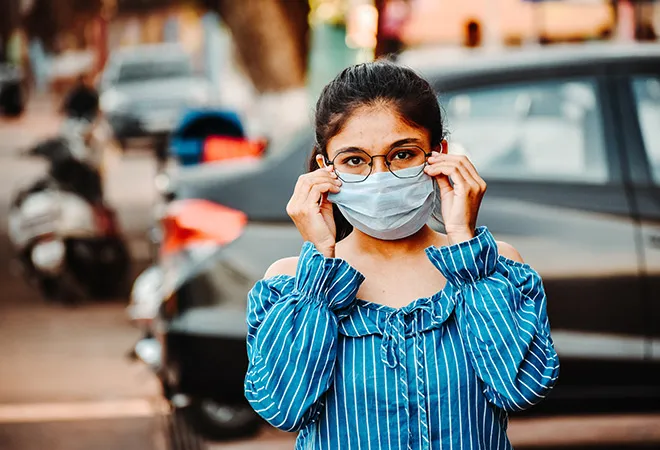
When news of Covid-19 outbreak came in early 2020, there was little clarity among world governments and societies on how they will be impacted, and what would be the best way to deal with the problem. By the time awareness grew and interventions were made, much damage had been done, both in developed as well as in developing nations.
Globally, since the beginning of this year, nearly 800,000 people have died and millions are suffering from various health disorders. Further, over this period of about eight months, while a decline in number of deaths and increase in patient recovery rates is observed due to untiring efforts of medical science community and health workers at various levels, there has been no set pattern of improvement as governments are still understanding and diagnosing the problem, as well as experimenting with the idea of locking and unlocking of human activities. According to WHO, it can take up to two years for normalcy to return. Thus, the threat is far from over.
To prevent the virus from spreading, all human activities – education, work, travel, play, leisure – were halted for several days/months, and governments advised citizens to take full precautions, including remaining at home, studying/working from home, using facial shields and masks, avoiding social mixing, etc. The lockdown was meant to break the chain of transmission of coronavirus.
At the same time, reopening of activities was considered necessary for social and economic reasons. In view of the difficulties posed by the pandemic and no signs of early normalisation of the situation, governments consider functioning with necessary precautions as the ideal way forward.
Towns and cities (or urban areas) have been most affected by the pandemic for two main reasons – it is here that more than one-half of the world’s population lives; affluent people travel frequently to domestic and international locations for a variety of reasons. Thus, when the problem reportedly occurred in China’s city, Wuhan, the to and fro movement of Chinese and foreign nationals probably led to its global spread. It is believed that with whomsoever these human carriers of the virus came in contact, majority of those people tested positive for coronavirus. While the problem has been created by affluent sections of society living in cities, its impact has been felt across geographical locations (urban and rural) and masses (rich and poor).
In India, the pandemic has created additional pressure on the already overburdened city planning and administration agencies. Some newly emerging challenges are mentioned here.
Public Health: Accessing reliable and affordable healthcare services has emerged as a serious issue. Generally, government health institutions are lagging in handling the load of in-patients and in creating additional health infrastructure/services. Many patients have suffered or died because they were denied admission in health institutions. Others complained about lack of information on beds availability, and hygiene standards. The private institutions, on the other hand, are expensive and there have been instances of patients denied admission because they did not furnish Covid-free certificates. Furthermore, the ill-planned drainage systems in cities caused flooding of health institutions during the monsoon season. Thus, action is needed on upgrading and maintenance of health institutions, planning for health emergencies, installation of superior ICT systems, and regulation of private institutions.
Education: With temporary closure of educational institutions due to the pandemic, efforts have been made to conduct online classes. However, in this format, many students are facing difficulty in coping with their studies. Two problems are noted in this regard – fast internet service is not available in some towns; children from economically weaker sections (EWS) are unable to attend as they do not possess smartphones and computers. With a surge in internet consumption during the Covid period, network speeds have slowed down. Educational institutions, on the other hand, are unable to conduct examinations in virtual format. Thus, making education remotely available to all students has emerged as an important task.
Employment and Income: The lockdowns have caused huge income and job losses in all economic sectors. With no shoppers and customers around, employers are unable to pay rent of premises and salaries to workers. Many small businesses have closed down. The construction industry, which employs a large number of workers, is in a critical state, as many on-going development projects have either come to a standstill or cancelled. Hill towns and other scenic places solely dependent on tourism are experiencing the worst economic crisis. With no work and money in hand, migrant workers engaged in a variety of informal occupations have returned to their native towns/villages. ILO mentions that these workers have been pushed deeper into poverty. Non-availability of workers in the informal sector has disrupted functioning of cities and led to soaring prices of essential goods and services. The national, state and local governments must offer support and create employment opportunities for people adversely affected by Covid-19 in both rural and urban areas. Deficiencies in national government initiatives such as NREGA and Rurban Mission must be overcome and the schemes should be effectively implemented.
Public Transport: Travel in public transport is risky during the Covid19 period as chances of catching the infection are high. While people from EWS have no option but to continue using public transport facilities, those with purchasing power will prefer buying and using their own vehicles, whether two or four wheelers. They will also avoid travelling in shared commercial (OLA, UBER) and shared private vehicles. This will lead to a phenomenal rise in private vehicle ownership as well as a larger number of motorised vehicles on city roads. Already Indian cities do not fare well on TomTom’s Traffic (congestion) Index and WHO’s Air Quality Rankings. Thus, greater efficiency in traffic and air quality management would be needed in the coming days. A wider application of intelligent transport system (ITS) technologies and shifting to cleaner motor vehicle fuels/electric vehicles is urgently needed.
Water and Sanitation: These are core elements of the pandemic recovery phase. A clean supply of water for washing hands frequently, and safe disposal of biomedical (as well as municipal) waste are most important requirements. However, deficiencies exist in the planning and management of these basic services. As a result, a large proportion of city dwellers living in informal areas do not have access to piped water supply; waste dumps on public places and along roads are a common sight. During the Covid19 period, irregularities by health institutions and households are observed in proper disposal of material used (such as disposable masks, gloves, PPE kits, etc.) for treatment of patients, which pose a huge risk of spreading infection to waste pickers and the public. Thus, greater administrative efficiency is required in provision of water and sanitation services.
The study of conditions prevailing in select urban sectors during the Covid19 period reveals deficiencies in city governance. This could be an important reason for the growth and spread of the pandemic in India. The present situation calls for finding ways to improve the functioning of city governments. Further, scope of India’s Smart Cities Mission must be widened to make cities more resilient.
The views expressed above belong to the author(s). ORF research and analyses now available on Telegram! Click here to access our curated content — blogs, longforms and interviews.




 PREV
PREV


